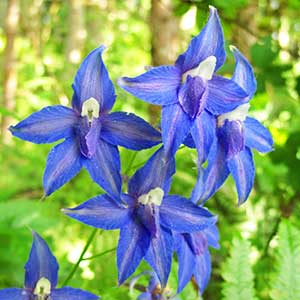Delphinium trolliifolium
Delphinium variegatum
Columbian larkspur, cow-poison, poison delphinium, poison larkspur
royal larkspur
(40-)60-120(-180) cm;
base usually reddish, glabrous to puberulent.
(10-)20-50(-80) cm;
base reddish or not, not longitudinally ridged, long-pubescent.
blade ± pentagonal, 4-8 × 7-16 cm, margins ± incised, nearly glabrous; ultimate lobes 0-9, width 15-30 mm (basal), 5-20 mm (cauline), widest at middle or in proximal 1/2.
blade round to pentagonal, 1-4.5 × 2-6 cm, pubescent; ultimate lobes 3-15, width 3-8 mm (basal), 2-5 mm (cauline).
(5-)14-40(-75)-flowered, ± open, at least 2 times longer than wide;
pedicel 1-4(-9) cm, puberulent to glabrous;
bracteoles (2-)6-12 mm from flowers, green, linear, 5-9(-14) mm, puberulent.
(4-)6-17(-20)-flowered, open;
pedicel 0.5-3(-7) cm, usually puberulent;
bracteoles 2-7(-23) mm from flowers, green, linear-lanceolate, 3-8 mm, puberulent.
sepals dark blue, glabrous, lateral sepals spreading, (8-)14-21 × 5-9 mm, spurs straight or downcurved at apex, within 20° of horizontal, (10-)16-23 mm;
lower petal blades covering stamens, 5-10 mm, clefts 1.5-3 mm;
hairs sparse, mostly near junction of blade and claw, centered or on inner lobes, well dispersed, yellow.
sepals usually deep royal blue, sometimes bright blue to light blue or white, ± finely pubescent, lateral sepals spreading, 10-18(-25) × 6-10 mm, spurs straight, ascending ca. 30° above horizontal, 10-19 mm;
lower petal blades slightly elevated, ± exposing stamens, 4-11 mm, clefts 0.5-3.5 mm;
hairs sparse, more on inner lobes than outer lobe or centered, scattered on margins, white or yellow.
(15-)23-34 mm, 3.8-5.5 times longer than wide, glabrous.
9-19 mm, 2.2-3.8 times longer than wide, ± puberulent.
unwinged;
seed coats smooth.
not echinate, appearing ± smooth to naked eye;
seed coat cells with margins ± undulate, surfaces roughened.
= 16.
Delphinium trolliifolium
Delphinium variegatum
Delphinium trolliifolium occurs in the northern Coast Range of California, the Columbia River Valley to just east of Mt. Hood, and the Willamette Valley of Oregon upstream to Lane County. California plants differ somewhat from Oregon plants in pubescence patterns and habitat preferences. Further study may show that two entities are involved here.
Hybrids between Delphinium trolliifolium and D. decorum, D. menziesii subsp. pallidum (D. ×pavonaceum Ewan, Peacock larkspur), D. nudicaule, D. nuttallianum, and D. nuttallii are known. Delphinium trolliifolium is likely to be confused only with D. bakeri. Refer to discussion under that species for differences.
(Discussion copyrighted by Flora of North America; reprinted with permission.)
Subspecies 3 (3 in the flora).
(Discussion copyrighted by Flora of North America; reprinted with permission.)
1. Long hairs dense on base of stem; sepals usually deep royal blue; mainland. | subsp. variegatum |
1. Long hairs sparse on proximal portion of stems; sepals white to bright blue; islands. | → 2 |
2. Sepals bright blue to light blue. | subsp. thornei |
2. Sepals white to light blue. | subsp. kinkiense |


